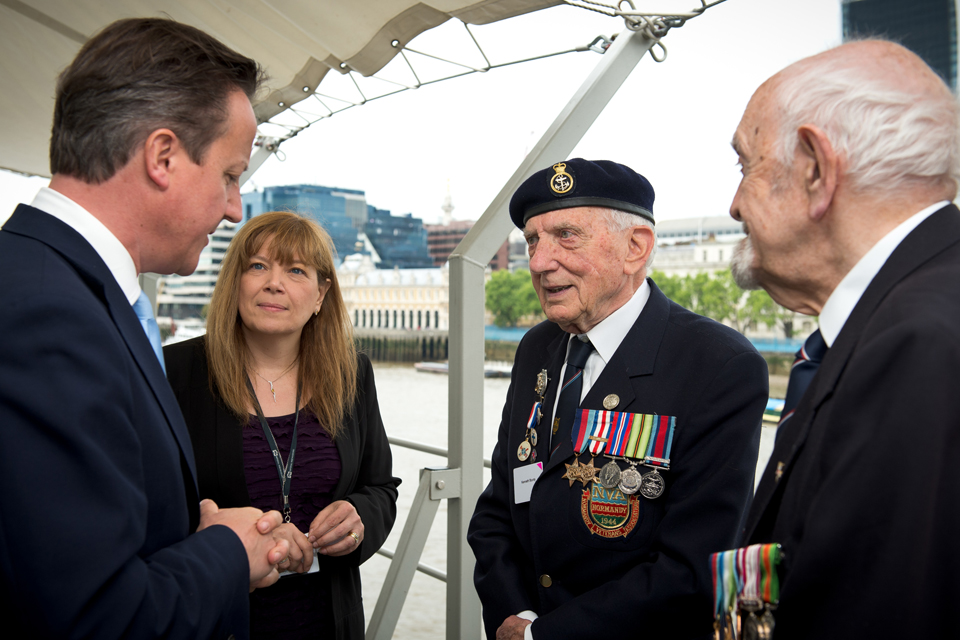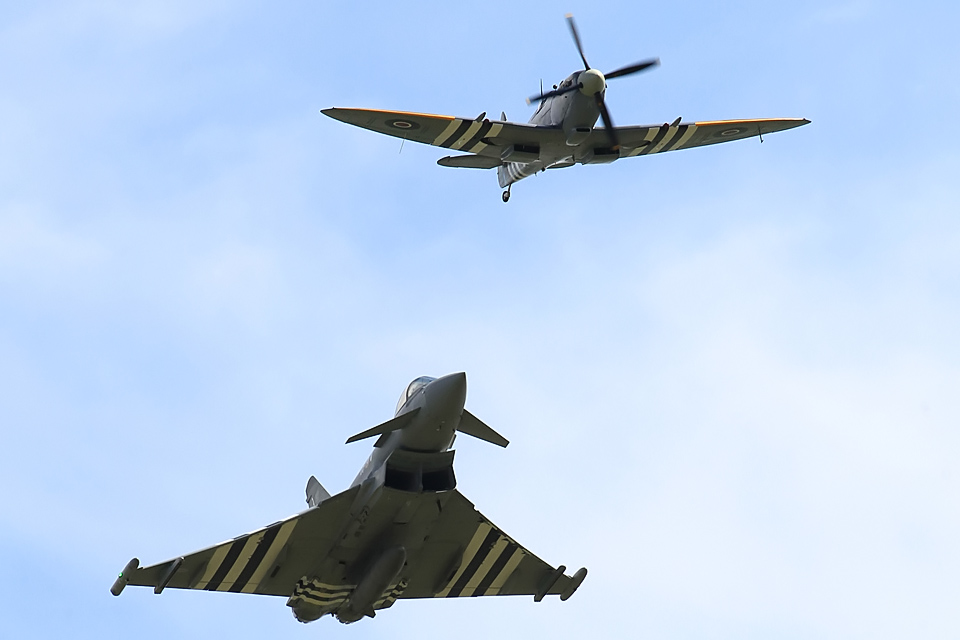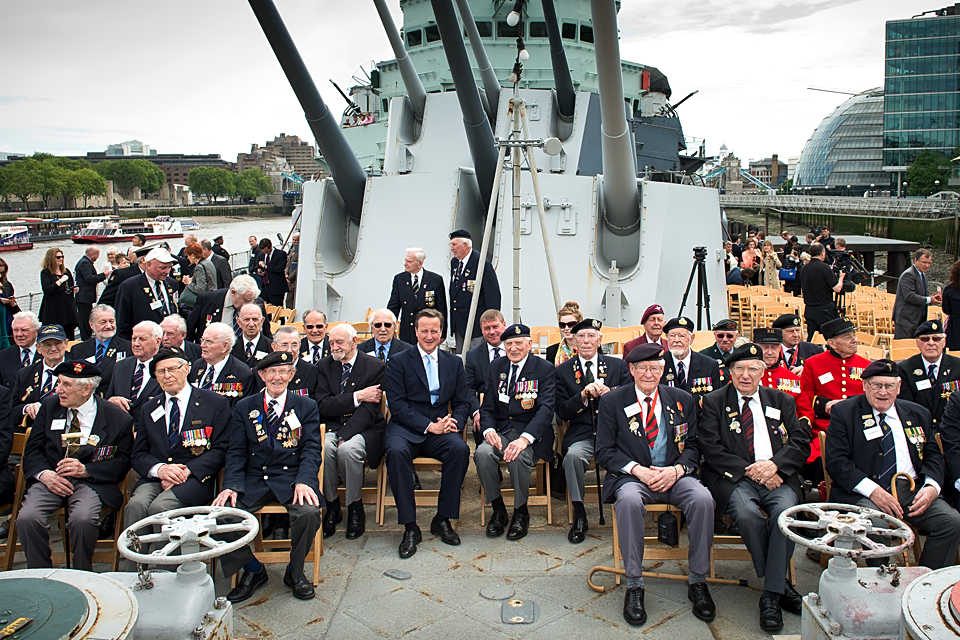D-Day commemorations commence
Ceremonies to mark the start of the 70th anniversary commemorations of the D-Day landings have taken place this week.
![A Second World War Douglas C-47 Dakota military transport aircraft flies over HMS Belfast [Picture: Sergeant Paul Shaw, Crown copyright]](https://assets.publishing.service.gov.uk/media/5a61f583e5274a0a37ef0450/s300_14227379542_ba8e70cf58_o.jpg)
A Douglas C-47 Dakota military transport aircraft flies over HMS Belfast
Prime Minister David Cameron joined D-Day veterans on Second World War warship HMS Belfast yesterday (20 May) at a ceremony to mark the forthcoming 70th anniversary of the Normandy landings.
The ship led the commemorations with a ceremony for veterans who served on it during the assault, as well as other veterans from the campaign, including Chelsea Pensioners and members of the Normandy Veterans Association. A Douglas C-47 Dakota flypast along the Thames on behalf of the RAF Battle of Britain Memorial Flight then followed.
During the ceremony, Mr Cameron said:
It’s a huge honour to be here today in such extraordinary company on such a magnificent ship. Seventy years on we look back on that day with awe, with pride, and with gratitude.

Prime Minister David Cameron meets veterans on board HMS Belfast [Picture: Sergeant Paul Shaw, Crown copyright]
Director of HMS Belfast, Phil Reed, said:
We felt it was important to give those veterans who are unable to attend the commemorations in Normandy an opportunity to mark the event in London, and HMS Belfast, having served at D-Day, is the most appropriate location to host such an event.
Also this week, HMS Bulwark gave a taster to the people of Gosport of what it will be doing as part of the commemorations on 5, 6 and 7 June.
Royal Marine and amphibious operations officer Lieutenant Colonel Rich Maltby described the demonstration:
We launched landing craft filled with marines from HMS Bulwark onto Browndown beach where they were then involved in a short fire fight.
We also sent the quick reaction force to engage the enemy and neutralise the threat.

Royal Marines, deployed from HMS Bulwark, assault Browndown beach in Gosport to practise the ship's amphibious capability [Picture: Leading Airman (Photographer) Rhys O'Leary, Crown copyright]
The assault ship will lead the Royal Navy’s contingent of 5 ships and Royal Marines, as well as an international flotilla, to the beaches of the coast of Normandy, France, where a number of high-profile ceremonies and services will be held.
The events will begin with a demonstration of the ship’s amphibious capability, in Southsea on 5 June, and culminate in services at the Bayeux Cathedral cemetery and Arromanches, and ceremonies at Sword Beach on 6 June and then at Port-en-Bessin on 7 June.
As part of the Royal Air Force’s contributions to the 70th anniversary D-Day commemorations, a specially-painted Typhoon jet with D-Day invasion stripes was unveiled at RAF Coningsby, Lincolnshire, where it also completed a dual flypast.
The state-of-the-art RAF Eurofighter Typhoon has been adorned with the iconic black and white invasion markings in a tribute to the significant role of the crews of the Hawker Typhoon, its Second World War namesake, particularly during D-Day operations.

A Typhoon sporting commemorative black and white invasion markings in flight with a Second World War Spitfire [Picture: Senior Aircraftman Clarke, Crown copyright]
Flying Officer (Retd) Paddy Byrne, 92, a Hawker Typhoon D-Day pilot, travelled to witness the unveiling and said:
It was marvellous seeing the Typhoon, but for me it was more about meeting the people; those who fly the aircraft and those who help to get it in the air in the first place. It’s been great comparing notes.
The D-Day landings
The landings, on 6 June 1944, involved a combination of British, Canadian, American and French forces, including hundreds of units from the Royal Navy. Around 132,000 Royal Marines and allied soldiers were transported by ships and injected onto the beaches of Normandy by landing craft and sea boat, with 23,400 arriving by air. The RAF and allied air forces provided air support with 11,000 aircraft.
The largest seaborne invasion ever launched, it was pivotal in heralding the end of the Second World War in Europe. However, that was at a cost of around 4,300 British and Commonwealth casualties listed as dead, wounded or missing.

Prime Minister David Cameron poses for a group photo with veterans on board HMS Belfast [Picture: Sergeant Paul Shaw, Crown copyright]